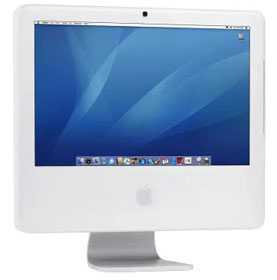Hosted by site sponsor WebMate.
White Intel iMac Q&A - Updated October 6, 2006
To be notified of new Q&As, sign up for EveryMac.com's bimonthly email list.
What is the difference between the consumer and education-only iMac "Core Duo"?
Please note that the iMac "Core Duo" models have been discontinued. These systems were replaced by the "White" iMac Core 2 Duo line.
On July 5, 2006, Apple introduced an education-only configuration of the iMac "Core Duo" 1.83 17" and discontinued the remaining education-only configuration of the eMac.
Oddly, on July 12, 2006, as first noticed by rumor site AppleInsider and easily verified by a visit to Apple's Education website, Apple quietly stopped selling the model to individuals within the education system and restricted its sale to educational institutions. No explanation was provided for the abrupt change after only a week, but some speculated that it was because Apple received a number of large institutional orders and wanted to fill those before accepting additional orders from individuals or that the lower priced model was cutting into sales of the higher-end iMac "Core Duo" 1.83 17" and lower-end Mac mini "Core Duo" 1.66.
Just from looking at the systems side-by-side, you would not be able to tell the difference between the education-only iMac "Core Duo" 1.83 17" (IG) as EveryMac.com has decided to refer to the system (explanation forthcoming) and its consumer-targeted brethren (which also was available for education).

Both systems use the same all-in-one enclosure (photo to the left courtesy of Apple Computer) with the entire computer tucked discreetly behind the same 17" TFT Active Matrix LCD (1440x900 native) flat-panel display. Internally, each has a 1.83 GHz Intel "Core Duo" processor (T2400), with two independent processor "cores" on a single silicon chip, a 2 MB shared level 2 cache, a 667 MHz system bus, and support for 667 MHz PC2-5300 DDR SDRAM. Ports are identical as well, including Gigabit Ethernet, and the education-only configuration still has an integrated iSight video camera, while some educators probably would prefer that it not.
The most important difference between the iMac "Core Duo" 1.83 17" (IG) system is that it uses cheaper and slower Intel GMA 950 "integrated graphics" compared to the much faster ATI Radeon X1600 "dedicated" graphics processor with 128 MB of GDDR3 memory used in the higher-end configuration. However, there are notable configuration differences as well.
For your convenience, these differences are summarized in this handy table:
| iMac "Core Duo" 1.83 17" (IG) | iMac "Core Duo" 1.83 17" | |
|---|---|---|
| Graphics System: | Intel GMA 950 | ATI Radeon X1600 |
| Optical Drive: | DVD-ROM/CD-RW | DVD+R DL/DVD±RW/CD-RW |
| Hard Drive: | 80 GB | 160 GB |
| Memory: | 512 MB (Two 256 MB Modules) | 512 MB (Single Module) |
| Bluetooth: | None | 2.0+EDR |
| Apple Remote: | None (Can Be Added) | Yes |
| Education Price: | US$899 | US$1199 |
In a nutshell, the education-only model cost US$300 less (or US$400 less than the consumer pricing) -- but has slower "integrated graphics", no DVD-R capabilities (single or dual layer), half as much hard drive storage, RAM pre-installed as two 256 MB memory modules (which was cheaper initially, more costly to upgrade to 1 GB of RAM, and beneficial for the performance of the integrated graphics system), no Bluetooth 2.0+EDR, and no remote (which likely was a welcome omission in an educational lab setting).
On July 6, 2006, EveryMac.com speculated that just as Apple originally introduced the eMac as an education-only model, and a few months later made it available for all customers, the company might do the same this time. Instead, on September 6, 2006, Apple introduced the iMac "Core 2 Duo" 1.83 17-Inch (IG). The "Core 2 Duo" model effectively has the same architecture, but uses a faster processor.
Permalink | Report an Error/Typo | Sign Up for Site Update Notices
<< White Intel iMac Q&A (Main)
Established in 1996, EveryMac.com has been created by experts with decades of experience with Apple hardware. EveryMac.com includes, and always has included, original research incorporating detailed, hands-on inspection of packaging, computers, and devices as well as extensive real-world use. All information is provided in good faith, but no website or person is perfect. Accordingly, EveryMac.com is provided "as is" without warranty of any kind whatsoever. EveryMac.com, and the authors thereof, shall not be held responsible or liable, under any circumstances, for any damages resulting from the use or inability to use the information within. For complete disclaimer and copyright information please read and understand the Terms of Use and the Privacy Policy before using EveryMac.com. Copying, scraping, or use of any content without expressed permission is not allowed, although links to any page are welcomed and appreciated.
